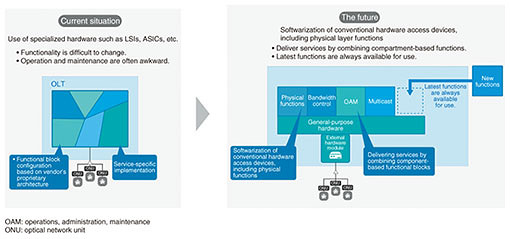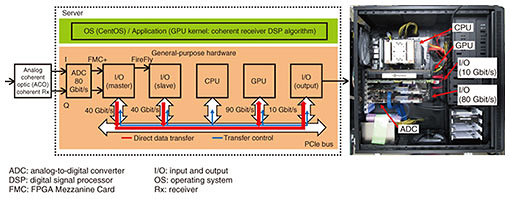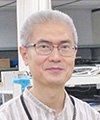Aiming to provide flexible services without being tied to dedicated hardware
—What exactly does research into ultra-high-speed full software access networks entail?
The optical access lines we have today need to provide services to user devices that each has different requirements when it comes to communications speed, latency, security, and so forth. What’s more, communications traffic rapidly increases as those services become more sophisticated and complex. In order to meet these requirements, each service provider uses access devices that consist of dedicated devices such as large-scale integration (LSI) and application-specific integrated circuits (ASICs) that are customized to the service’s specifications.
However, there are also some drawbacks to using hardware based on these dedicated devices (i.e., dedicated hardware). First of all, the nature of dedicated hardware is such that once it has been manufactured and implemented, its functionality cannot be changed. This makes it difficult to respond flexibly to additions or changes to the service, and tends to make operation and maintenance tasks awkward.
We therefore expect to see software-based networks become a reality. These are networks where the functions of all the constituent devices are softwarized and can be freely combined on servers and offered as services. This would allow quick responses to security emergencies, as hardware changes would not be required when new services are needed, and the latest functionality would always be available. If software-based networks become a reality, they will enable support for a variety of services, such as services for next-generation mobile devices, edge computing, and the Internet of Things.
To achieve this, I have been focusing on the softwarization of the physical layer functionality of communications networks—something that has typically posed a challenge. I am currently working on research into the full softwarization of the physical layer—in other words, the transmission interface—that performs the lower-layer processing in optical access equipment that has so far been handled by hardware such as optical line terminals (OLTs). To put it more technically, I am working on the softwarization of digital coherent modulation and demodulation systems.
I am planning to use general-purpose server central processing units (CPUs), graphics processing units (GPUs), and other processors to handle these processes using programming, coding, and other techniques (Fig. 1).

Fig. 1. Research into ultra-high-speed full software access networks.
—What are the challenges of softwarization?
When you take into account 6G (sixth-generation mobile communications system), the mobile communications standard that will succeed 5G (fifth-generation mobile communications system), and future communications between datacenters, we will eventually end up needing overwhelming speeds of 100 Gbit/s. However, increasing speeds using general-purpose processors is very challenging due to fundamental limitations, such as constraints in the semiconductor manufacturing process.
There are already fully softwarized networks, but their speeds are still only at about 100 Mbit/s at present. That’s a mere 1/1000th of the 100 Gbit/s I am aiming for—quite an astounding difference in speeds. Therefore, in this research I am trying to overcome this problem by focusing on devising logic algorithms optimized for general-purpose processors such as CPUs, coprocessors, GPUs, and field programmable gate arrays (FPGAs). Increasing the speed is potentially the biggest challenge in making software-based networks a reality in the future.
—What progress has been made to date?
In 2018, a proof of concept of a software-coherent platform using differential phase shift keying achieved a world-first 5 Gbit/s, and was accepted as a top-scoring paper at the Optical Fiber Communication (OFC) Conference, a prestigious international conference in the field of optical communications.
In 2021, another world-first speed of 10 Gbit/s was achieved—double that achieved in 2018—using a proprietary carrier phase-locking algorithm. This accomplishment was also presented in a paper at the European Conference on Optical Communication, a similarly prestigious international conference in the field of optical communications.
This increase in communications speed from 5 Gbit/s to 10 Gbit/s is mainly due to improvements in logic algorithms. Increasing the bit rate, or communications speed, naturally increases the amount of data transmitted per unit of time. For example, the amount of data per unit of time doubles with an increase from 5 Gbit/s to 10 Gbit/s. First, that doubled data have to be input to the server and processed by the CPU, GPU, and other processors. There are already established logic algorithms for data processing, but as the volume of data increases, real-time processing is no longer able to keep up. This is why logic algorithms have so far been optimized for CPUs and GPUs in order to increase speed. If we express the target of 100 Gbit/s as 100%, then we can say that at this point we have achieved about 10% of this target (Fig. 2).

Fig. 2. 10-Gbit/s software-coherent platform.
Aiming to develop software-based access networks in the future
—What outcomes could this research produce?
Communications services have evolved from Integrated Services Digital Network to asymmetric digital subscriber lines, and then to optical access (fiber to the home). Communications speeds have also evolved—from 100 Mbit/s to 1 Gbit/s, and then to services reaching 10 Gbit/s in 2020. In the mobile field in particular, the focus of the discussion is shifting from 5G to 6G, and I feel that the role of access-segment communications—the foundation that supports these technologies—is growing. This research will likely prove beneficial in creating mechanisms that adapt flexibly to and provide support in this area.
In addition, relatively inexpensive general-purpose hardware will become able to support a variety of future service requirements, such as for high-speed wired optical communications and next-generation mobile communications. This will dramatically expand the diversity and flexibility of optical access and is anticipated to reduce equipment installation, operation, and maintenance costs. There are still many hurdles to overcome in terms of practical use, but I believe this will contribute to the Innovative Optical and Wireless Network (IOWN) vision, which I expect to see implemented in society in the future.
—Can you tell us about future developments in this research?
The approach of this research is to optimize software algorithms to increase speeds. However, the key focus of this is creating new algorithms to improve speeds, rather than improving current algorithms. I hope to make new breakthroughs and achieve our target speed of 100 Gbit/s or faster. Furthermore, by integrating the softwarized physical layer with the application layer, I intend to build a new ecosystem that will increase the number of my fellow collaborators from different fields and industries.
—What kind of initiatives will be needed to further advance this research?
I hope to advance this research effectively through the establishment of strategic collaboration frameworks with advanced research organizations in relevant fields. General-purpose processors, of course, have inferior performance compared to that of processors customized for a specific function. However, they do offer advantages such as flexibility, so there will surely be a need for algorithms that are tailored to suit them. For this reason, it would certainly be beneficial to work with people who have a good knowledge of general-purpose processors.
In addition, this research requires not only digital programming skills, but also knowledge of electrical circuits, server hardware, and a variety of other things, so I also envision establishing strategic collaboration frameworks with companies that develop server hardware. I know Japanese companies have been developing server-related hardware for years with an extremely high level of focus, so I hope to be of use in that area, as well as accelerating my research. For example, I can envision working together with businesses that develop hardware, software, and other solutions for datacenters. It will also be possible to integrate applications into the softwarized physical layer, which could be beneficial for connecting with businesses that develop and provide services. Furthermore, as data transfer speeds increase, so too does the need for large volumes of data to be sent within the server. That being the case, it would be good if I could establish collaboration frameworks with anyone familiar with data transfer, i.e., speeding up interfaces such as Peripheral Component Interconnect and transferring data to the server’s memory.

